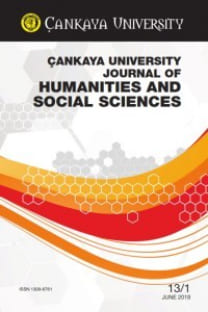Henry James’s Prefatory Discourse as a Site for Innovation, Construction, and Instruction
This study attempts to show the distinct features of Henry James’s prefaces as a body of criticism that provides the receiver with new cues to read not only his narratives but also fiction in general. It aims to demonstrate how his prefatory discourse becomes a site for literary criticism and an extra-textual space that allows the author to communicate his “lessons” on new fiction theories rather than an illustrative pre-text that discloses the author’s objectives. Through an unconventional use of prefaces, James endeavors to change the reading habits of the past by making the modern reader aware of his rebellious style and innovative theories of fiction and acquainting him/her with a different treatment of the literary text in the critical act. James is known to have adopted new techniques, like stream of consciousness and the scenic method, in his novels and instructs the reader in his prefaces to focus on the character and pay heed to the governing intelligence in the narrative, thereby providing a philosophical account of the relationship between art and the artist, and art and life.
Anahtar Kelimeler:
Henry James, preface, prefatory discourse, nineteenth-century narrative, innovation
Henry James’s Prefatory Discourse as a Site for Innovation, Construction, and Instruction
This study attempts to show the distinct features of Henry James’s prefaces as a body of criticism that provides the receiver with new cues to read not only his narratives but also fiction in general. It aims to demonstrate how his prefatory discourse becomes a site for literary criticism and an extra-textual space that allows the author to communicate his “lessons” on new fiction theories rather than an illustrative pre-text that discloses the author’s objectives. Through an unconventional use of prefaces, James endeavors to change the reading habits of the past by making the modern reader aware of his rebellious style and innovative theories of fiction and acquainting him/her with a different treatment of the literary text in the critical act. James is known to have adopted new techniques, like stream of consciousness and the scenic method, in his novels and instructs the reader in his prefaces to focus on the character and pay heed to the governing intelligence in the narrative, thereby providing a philosophical account of the relationship between art and the artist, and art and life.
___
“Preface,” Def. N. 1.5. User Contributed Dictionary, proem.askdefine.com/#wk. Accessed 23 January 2018.Blackmur, Richard D. Introduction. The Art of the Novel: Critical Prefaces. Charles Scribners Sons Ltd., 1934.
Carlson, Susan. “Henry James the Dramatist.” A Companion to Henry James Studies, edited by Daniel Mark Fogel, Greenwood Press, 1993, pp.407-426.
James, Henry. The Art of the Novel: Critical Prefaces. Charles Scribners Sons Ltd., 1934.
---. The Notebooks of Henry James, edited by F.O. Matthiessien and B. Murdock, Geoprge Braziller Inc., 1955. The Internet Archives, archive.org/stream/in.ernet. dli.2015.3343/2015.3343.The-Notebooks-Of-Henry-James_djvu.txt.
James, Henry and Walter Besant. The Art of Fiction. Cupples, Upham and Company, 1885.
Murphy, Brenda. American Realism and American Drama, 1880-1940. Cambridge University Press, 1990.
Perosa, Sergio. Henry James and the Experimental Novel. New York University Press, 1983.
Rundle, Vivienne. “Defining Frames: The Prefaces of Henry James and Joseph Conrad.” The Henry James Review, vol.16, no.1, 1995, pp. 66-92. Project Muse, doi:10.1353/hjr.1995.0008.
Seltzer, Mark. “The Princess Casamassima: Realism and the Fantasy of Surveillance.” American Realism: New Essays, edited by Eric J. Sundquist, The Johns Hopkins University Press, 1982, pp. 95- 118.
Spender, Stephen. “The Contemporary Subject.” A Collection of Critical Essays, edited by Leon Edel. Prentice – Hall International, 1987, pp.102- 110.
Wilson, Frances. “The James Family Theatricals: Behind the Scenes.” The Cambridge Companion to Henry James. Cambridge University Press, 1998.
- ISSN: 1309-6761
- Yayın Aralığı: Yılda 2 Sayı
- Başlangıç: 2004
- Yayıncı: Çankaya Üniversitesi
Sayıdaki Diğer Makaleler
Hanif Kureishi’s The Last Word: The Art of Fictional Biography
Decolonization of policy process and not the policy of decolonization
Epistolography of the Repressed: Writer/Iwaszkiewicz, Reader/Karpowicz
Henry James’s Prefatory Discourse as a Site for Innovation, Construction, and Instruction
Encarnación ALMAZÁN-RUİZ, Aroa ORREQUİA-BAREA
